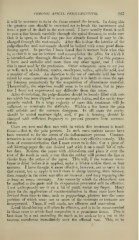Page 917 - My FlipBook
P. 917
CHRONIC APICAL PERICEMENTITIS. 927
it Avill be necessary to twist the tissue around the broach. In doing this
the greatest care should be exercised not to break the instrument and
leave a part of its shaft in the root-canal. I have usually found it well
to pass a fine broach carefully through the apical foramen, to make sure
that it is open, so that if any pus has already formed it may be dis-
charged through the root-canals. After this is done the interior of the
pulp-chamber and root-canals should be bathed with some good disin-
fecting agent. In practice I have found that it matters little what this
is, so that it is not an irritant and accomplishes the office for which it
is intended—the thorough disinfection of the parts. For this purpose
I have used carbolic acid more than any other agent, and I think
this is most used by the profession. Other substances seem to act just
as well, such as iodoform, sanitas, eucalyptus, iodine, salicylic acid, and
a number of others. An objection to the use of carbolic acid has been
raised by some operators on the ground that it is liable to close the api-
cal foramen prematurely by the coagulation of albuminous material.
Theoretically, the objection would seem to be well taken, but in prac-
tice I have not experienced any difficulty from this cause.
After disinfecting, the pulp-chamber should be loosely filled with cot-
ton which has been dipped in some antiseptic lotion, and the cavity tem-
porarily sealed. In a large majority of cases this treatment will he
sufficient to terminate the difficulty. Within a few hours the pain
will subside and the soreness disappear. In all cases the cavity
should be sealed moisture-tight, and, if pus is forming, should be
changed with sufficient frequency to prevent pressure from accumu-
lation.
Cases are now' and then met with in which this treatment is insuf-
ficient—that is, the pain persists. In such cases various means have
been resorted to for the arrest of the inflammatory process. Counter-
irritation is one of the simplest, and is often a very effective remedy. The
form of counter-irritation that I most resort to is this : Cut a piece of
soft blotting-paper the size desired and stick it on a small bit of rub-
ber dam. Moisten the paper with chloroform, and place it over the
root of the tooth in such a way that the rubber will protect the lips or
cheeks from the action of the agent. This will, if the mucous mem-
brane is dried before it is applied, make a blister within three or four
minutes. I have thought it more effective, however, not to carry it to
that extent, but to apply it until there is sharp burning, then remove,
then reapply in the same way after an interval ; and keep repeating this
as long as seems necessary. Any means by which the chloroform can
.
be applied to the parts and its evaporation prevented will be effective.
I not unfrequently use it on a bit of punk, under my finger. Many
plans for the application of counter-irritation in these cases have been
devised from time to time, such as pepper-bags, plasters into the com-
position of which some one or more of the vesicants or irritants are
incorporated. These, if well made, are effective and convenient.
Local blood-letting will often be effective, and is to be recommended
in those cases in which local congestion is a prominent factor. This is
best clone by a cut encircling the tooth at its neck or by a cut in the
mucous membrane immediately over the affected root. This, to be


